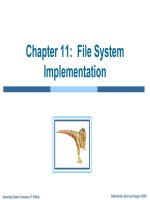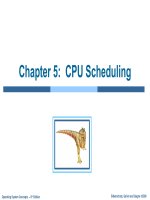Bài giảng hệ điều hành nâng cao chapter 1 introduction
Bạn đang xem bản rút gọn của tài liệu. Xem và tải ngay bản đầy đủ của tài liệu tại đây (1.89 MB, 48 trang )
Chapter 1: Introduction
Operating System Concepts – 8
th
Edition
Silberschatz, Galvin and Gagne ©2009
Chapter 1: Introduction
■
What Operating Systems Do
■
Computer-System Organization
■
Computer-System Architecture
■
Operating-System Structure
■
Operating-System Operations
■
Process Management
■
Memory Management
■
Storage Management
■
Protection and Security
■
Distributed Systems
■
Special-Purpose Systems
■
Computing Environments
■
Open-Source Operating Systems
Operating System Concepts – 8
th
Edition
1.2
Silberschatz, Galvin and Gagne ©2009
Objectives
■
To provide a grand tour of the major operating systems components
■
To provide coverage of basic computer system organization
Operating System Concepts – 8
th
Edition
1.3
Silberschatz, Galvin and Gagne ©2009
What is an Operating System?
■
A program that acts as an intermediary between a user of a computer and the computer hardware
■
Operating system goals:
●
Execute user programs and make solving user problems easier
●
Make the computer system convenient to use
●
Use the computer hardware in an efficient manner
Operating System Concepts – 8
th
Edition
1.4
Silberschatz, Galvin and Gagne ©2009
Computer System Structure
■
Computer system can be divided into four components:
●
Hardware – provides basic computing resources
●
Operating system
●
CPU, memory, I/O devices
Controls and coordinates use of hardware among various applications and users
Application programs – define the ways in which the system resources are used to solve the computing
problems of the users
●
Word processors, compilers, web browsers, database systems, video games
Users
Operating System Concepts – 8
th
People, machines, other computers
Edition
1.5
Silberschatz, Galvin and Gagne ©2009
Four Components of a Computer System
Operating System Concepts – 8
th
Edition
1.6
Silberschatz, Galvin and Gagne ©2009
What Operating Systems Do
■
Depends on the point of view
■
Users want convenience, ease of use
●
Don’t care about resource utilization
■
But shared computer such as mainframe or minicomputer must keep all users happy
■
Users of dedicate systems such as workstations have dedicated resources but frequently use shared resources from servers
■
Handheld computers are resource poor, optimized for usability and battery life
■
Some computers have little or no user interface, such as embedded computers in devices and automobiles
Operating System Concepts – 8
th
Edition
1.7
Silberschatz, Galvin and Gagne ©2009
Operating System Definition
■
■
OS is a resource allocator
●
Manages all resources
●
Decides between conflicting requests for efficient and fair resource use
OS is a control program
●
Controls execution of programs to prevent errors and improper use of the computer
Operating System Concepts – 8
th
Edition
1.8
Silberschatz, Galvin and Gagne ©2009
Operating System Definition (Cont.)
■
No universally accepted definition
■
“Everything a vendor ships when you order an operating system” is good approximation
●
■
But varies wildly
“The one program running at all times on the computer” is the kernel. Everything else is either a system program
(ships with the operating system) or an application program.
Operating System Concepts – 8
th
Edition
1.9
Silberschatz, Galvin and Gagne ©2009
Computer Startup
■
bootstrap program is loaded at power-up or reboot
●
Typically stored in ROM or EPROM, generally known as firmware
●
Initializes all aspects of system
●
Loads operating system kernel and starts execution
Operating System Concepts – 8
th
Edition
1.10
Silberschatz, Galvin and Gagne ©2009
Computer System Organization
■
Computer-system operation
●
One or more CPUs, device controllers connect through common bus providing access to shared memory
●
Concurrent execution of CPUs and devices competing for memory cycles
Operating System Concepts – 8
th
Edition
1.11
Silberschatz, Galvin and Gagne ©2009
Computer-System Operation
■
I/O devices and the CPU can execute concurrently
■
Each device controller is in charge of a particular device type
■
Each device controller has a local buffer
■
CPU moves data from/to main memory to/from local buffers
■
I/O is from the device to local buffer of controller
■
Device controller informs CPU that it has finished its operation by causing an interrupt
Operating System Concepts – 8
th
Edition
1.12
Silberschatz, Galvin and Gagne ©2009
Common Functions of Interrupts
■
Interrupt transfers control to the interrupt service routine generally, through the interrupt vector, which contains the
addresses of all the service routines
■
Interrupt architecture must save the address of the interrupted instruction
■
Incoming interrupts are disabled while another interrupt is being processed to prevent a lost interrupt
■
A trap is a software-generated interrupt caused either by an error or a user request
■
An operating system is interrupt driven
Operating System Concepts – 8
th
Edition
1.13
Silberschatz, Galvin and Gagne ©2009
Interrupt Handling
■
The operating system preserves the state of the CPU by storing registers and the program counter
■
Determines which type of interrupt has occurred:
■
●
polling
●
vectored interrupt system
Separate segments of code determine what action should be taken for each type of interrupt
Operating System Concepts – 8
th
Edition
1.14
Silberschatz, Galvin and Gagne ©2009
Interrupt Timeline
Operating System Concepts – 8
th
Edition
1.15
Silberschatz, Galvin and Gagne ©2009
I/O Structure
■
■
After I/O starts, control returns to user program only upon I/O completion
●
Wait instruction idles the CPU until the next interrupt
●
Wait loop (contention for memory access)
●
At most one I/O request is outstanding at a time, no simultaneous I/O processing
After I/O starts, control returns to user program without waiting for I/O completion
●
System call – request to the operating system to allow user to wait for I/O completion
●
Device-status table contains entry for each I/O device indicating its type, address, and state
●
Operating system indexes into I/O device table to determine device status and to modify table entry to include
interrupt
Operating System Concepts – 8
th
Edition
1.16
Silberschatz, Galvin and Gagne ©2009
Direct Memory Access Structure
■
Used for high-speed I/O devices able to transmit information at close to memory speeds
■
Device controller transfers blocks of data from buffer storage directly to main memory without CPU intervention
■
Only one interrupt is generated per block, rather than the one interrupt per byte
Operating System Concepts – 8
th
Edition
1.17
Silberschatz, Galvin and Gagne ©2009
Storage Structure
■
Main memory – only large storage media that the CPU can access directly
●
Random access
●
Typically volatile
■
Secondary storage – extension of main memory that provides large nonvolatile storage capacity
■
Magnetic disks – rigid metal or glass platters covered with magnetic recording material
●
Disk surface is logically divided into tracks, which are subdivided into sectors
●
The disk controller determines the logical interaction between the device and the computer
Operating System Concepts – 8
th
Edition
1.18
Silberschatz, Galvin and Gagne ©2009
Storage Hierarchy
■
■
Storage systems organized in hierarchy
●
Speed
●
Cost
●
Volatility
Caching – copying information into faster storage system; main memory can be viewed as a cache for secondary storage
Operating System Concepts – 8
th
Edition
1.19
Silberschatz, Galvin and Gagne ©2009
Storage-Device Hierarchy
Operating System Concepts – 8
th
Edition
1.20
Silberschatz, Galvin and Gagne ©2009
Caching
■
Important principle, performed at many levels in a computer (in hardware, operating system, software)
■
Information in use copied from slower to faster storage temporarily
■
Faster storage (cache) checked first to determine if information is there
■
●
If it is, information used directly from the cache (fast)
●
If not, data copied to cache and used there
Cache smaller than storage being cached
●
Cache management important design problem
●
Cache size and replacement policy
Operating System Concepts – 8
th
Edition
1.21
Silberschatz, Galvin and Gagne ©2009
Computer-System Architecture
■
Most systems use a single general-purpose processor (PDAs through mainframes)
●
■
Most systems have special-purpose processors as well
Multiprocessors systems growing in use and importance
●
Also known as parallel systems, tightly-coupled systems
●
Advantages include:
●
1.
Increased throughput
2.
Economy of scale
3.
Increased reliability – graceful degradation or fault tolerance
Two types:
1.
Asymmetric Multiprocessing
2.
Symmetric Multiprocessing
Operating System Concepts – 8
th
Edition
1.22
Silberschatz, Galvin and Gagne ©2009
How a Modern Computer Works
A von Neumann architecture
Operating System Concepts – 8
th
Edition
1.23
Silberschatz, Galvin and Gagne ©2009
Symmetric Multiprocessing Architecture
Operating System Concepts – 8
th
Edition
1.24
Silberschatz, Galvin and Gagne ©2009
A Dual-Core Design
Operating System Concepts – 8
th
Edition
1.25
Silberschatz, Galvin and Gagne ©2009









